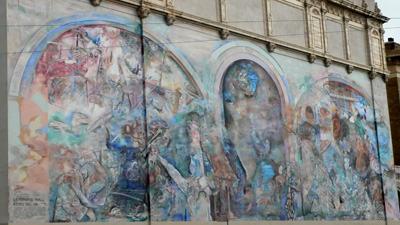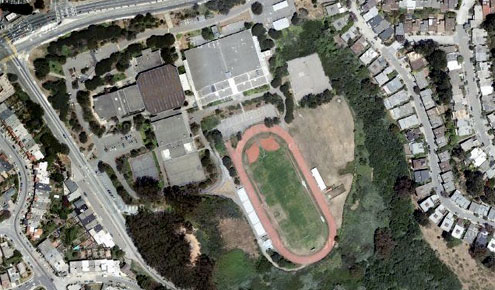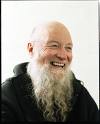 The San Francisco Public Schools commission is running a marketing campaign right now. The slogan on posters dotted in bus shelters and elsewhere around town is “The City is Our Classroom.” “That’s all well and good,” I thought as I walked passed a poster on a walk around the neighborhood this morning. “But that doesn’t make up for the fact that classrooms, in the conventional use of the word, aren’t necessarily doing their job anymore in this city.” I was thinking in particular of my recent visit to San Francisco’s rundown School of the Arts (SOTA) (see my blog entry of two days ago) which left a a bitter taste in my mouth.
The San Francisco Public Schools commission is running a marketing campaign right now. The slogan on posters dotted in bus shelters and elsewhere around town is “The City is Our Classroom.” “That’s all well and good,” I thought as I walked passed a poster on a walk around the neighborhood this morning. “But that doesn’t make up for the fact that classrooms, in the conventional use of the word, aren’t necessarily doing their job anymore in this city.” I was thinking in particular of my recent visit to San Francisco’s rundown School of the Arts (SOTA) (see my blog entry of two days ago) which left a a bitter taste in my mouth.
In this pensive mood, I walked around the corner and came across Keith Sklar’s 1989 mural, “Learning Wall.” Sklar’s enormous, psychadelic triptych is looking really faded. I read somewhere online that the artist had scrubbed out some portions of it a while ago. Not sure if that’s true, or if it is, why he would have done such a thing.
I walk past Sklar’s mural almost every day as I live close by, but not until this morning did I really stop to look at it closely. It’s hard to figure out what’s going on as the work is so busy. The main theme (a popular one in Bay Area murals) seems to be cultural pluralism. There are Inca heads, Chinese stringed musical instruments, Ancient Egyptian effigies and all manner of patterns and people. At the top is a motif of people holding hands. The whole thing swirls with color and texture like a giant bubbling cauldron of knowledge and ideas.
I can’t say it’s beautiful to look at, especially in its current faded, grimy state. But it serves as a reminder that education was at one point prized in this city. The mural is painted, somewhat ironically, on the side of an old, vacant and rather beautiful Department of Education building. I heard rumors that SOTA is eventually supposed to move from its current location in the fog belt into these premises. Financing, I suppose, prevents this from happening any time soon (if indeed this plan is more than a rumor.) It would be great if SOTA would move downtown. That would put the arts high school right next to the Symphony, Opera, Ballet and Conservatory of Music, not to mention the New Conservatory Theatre Center, The Asian Art Museum, the main branch of the San Francisco Library, the Herbst Theatre and several private galleries.
I imagine Sklar’s “Learning Wall” is more likely to get a fresh coat of paint before that happens though.

 It’s a wonder that I ever got sent to the US as a technology correspondent for a major British newspaper back in 2000, really. My lack of prowess at — and genuine interest in — figuring out the nuts and bolts of everyday applications I use is not something of which I’m proud. But there’s only so many things I can pay attention to on any given day, and worrying about which format I transfer audio files to and from my laptop sadly isn’t one of them.
It’s a wonder that I ever got sent to the US as a technology correspondent for a major British newspaper back in 2000, really. My lack of prowess at — and genuine interest in — figuring out the nuts and bolts of everyday applications I use is not something of which I’m proud. But there’s only so many things I can pay attention to on any given day, and worrying about which format I transfer audio files to and from my laptop sadly isn’t one of them. Articles about how the recession is affecting the arts in San Francisco are commonplace these days. Janos Gereben’s October 25
Articles about how the recession is affecting the arts in San Francisco are commonplace these days. Janos Gereben’s October 25  In the middle of the San Francisco
In the middle of the San Francisco  It’s a curious and not always desirable thing when an artist becomes so closely identified with one canonical work that the rest of their work gets ignored.
It’s a curious and not always desirable thing when an artist becomes so closely identified with one canonical work that the rest of their work gets ignored. Ukulele virtuoso Jake Shimabukuro has made a name for himself for pushing the ukulele to its aesthetic limits. But is it necessary to push the instrument so far that we don’t get to hear the uke at all? Shimabukuro’s
Ukulele virtuoso Jake Shimabukuro has made a name for himself for pushing the ukulele to its aesthetic limits. But is it necessary to push the instrument so far that we don’t get to hear the uke at all? Shimabukuro’s  A question to all you culture writers and artists out there: How do you cope with the guilt of not getting to experience even a fraction of your city’s arts offerings? It’s an embarrassment of riches.
A question to all you culture writers and artists out there: How do you cope with the guilt of not getting to experience even a fraction of your city’s arts offerings? It’s an embarrassment of riches. Sick of boring standing ovations and polite clapping? Wish audiences would show their feelings about a performance in a more visceral way? The San Francisco-based theatre company
Sick of boring standing ovations and polite clapping? Wish audiences would show their feelings about a performance in a more visceral way? The San Francisco-based theatre company  As every understudy knows, it’s very difficult stepping into a star’s shoes when you know everyone has paid to see someone else in the role — not you.
As every understudy knows, it’s very difficult stepping into a star’s shoes when you know everyone has paid to see someone else in the role — not you. Had an unusual performance experience yesterday which threw up some thoughts about the nature of the exchange that happens between performers and audiences. I was part of a small group of singers drafted under the auspices of a current member of the University of California at San Francisco medical faculty to perform songs for patients on the wards of the university cancer center. I jumped at the chance to sing with this group because I have been interested for a while in the efficacy of arts programs in hospitals and heard great things about the uplifting effect that singing can have on the spirits of people in poor health.
Had an unusual performance experience yesterday which threw up some thoughts about the nature of the exchange that happens between performers and audiences. I was part of a small group of singers drafted under the auspices of a current member of the University of California at San Francisco medical faculty to perform songs for patients on the wards of the university cancer center. I jumped at the chance to sing with this group because I have been interested for a while in the efficacy of arts programs in hospitals and heard great things about the uplifting effect that singing can have on the spirits of people in poor health. Real sorrow is very hard to pull off on stage or screen. I often think that if you want audiences to feel the weight of a character’s woes as a screen or playwright, you’re usually better off getting them to do something funny, rather than give them a crying scene. It’s just really hard to act sadness convincingly. Even if we can see that a character is deeply upset about something, it’s a rare actor who can make us actually feel their pain.
Real sorrow is very hard to pull off on stage or screen. I often think that if you want audiences to feel the weight of a character’s woes as a screen or playwright, you’re usually better off getting them to do something funny, rather than give them a crying scene. It’s just really hard to act sadness convincingly. Even if we can see that a character is deeply upset about something, it’s a rare actor who can make us actually feel their pain. Perhaps the most interesting detail that came up in last night’s Theatre Critics’ Panel organized by
Perhaps the most interesting detail that came up in last night’s Theatre Critics’ Panel organized by